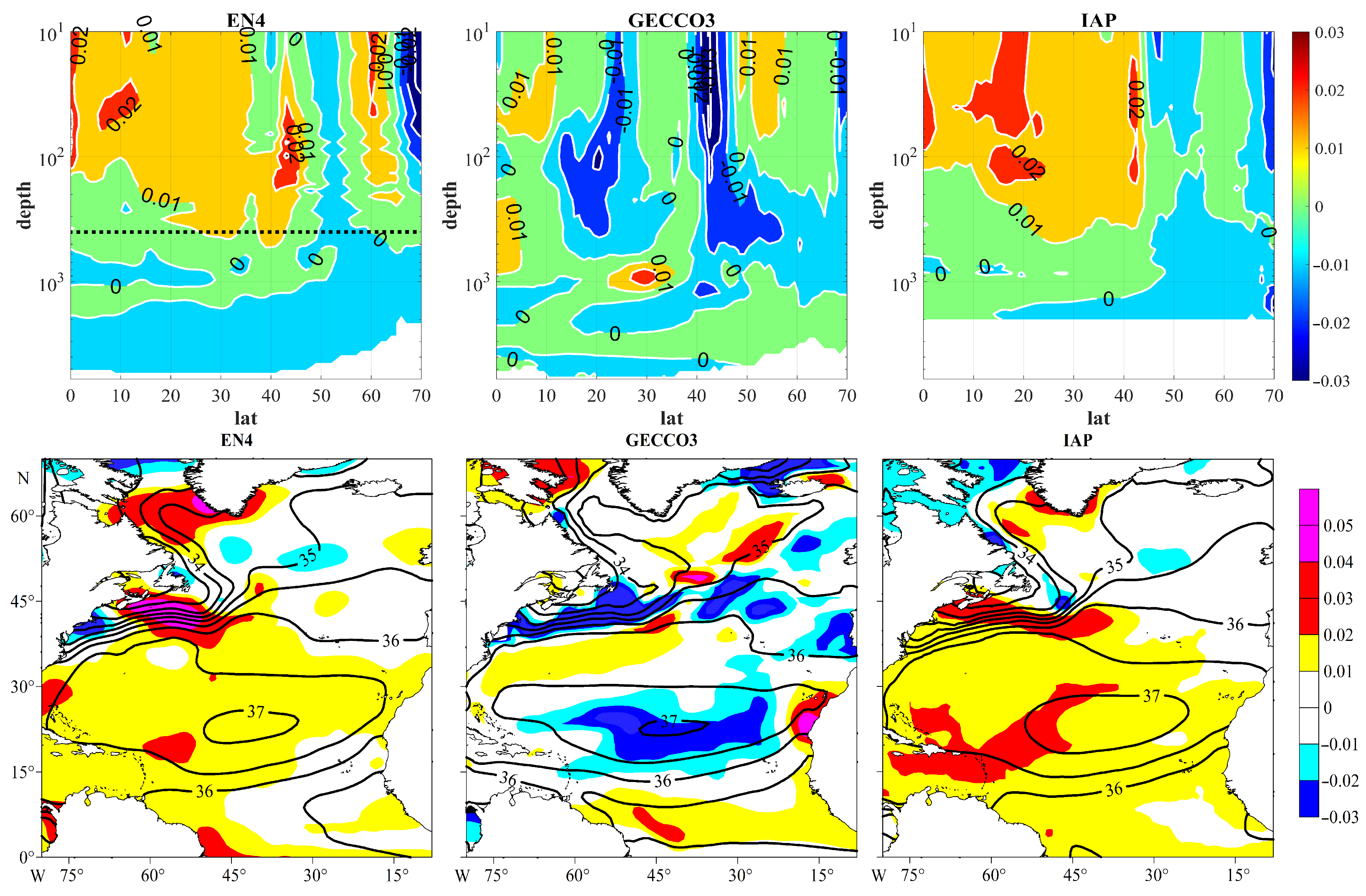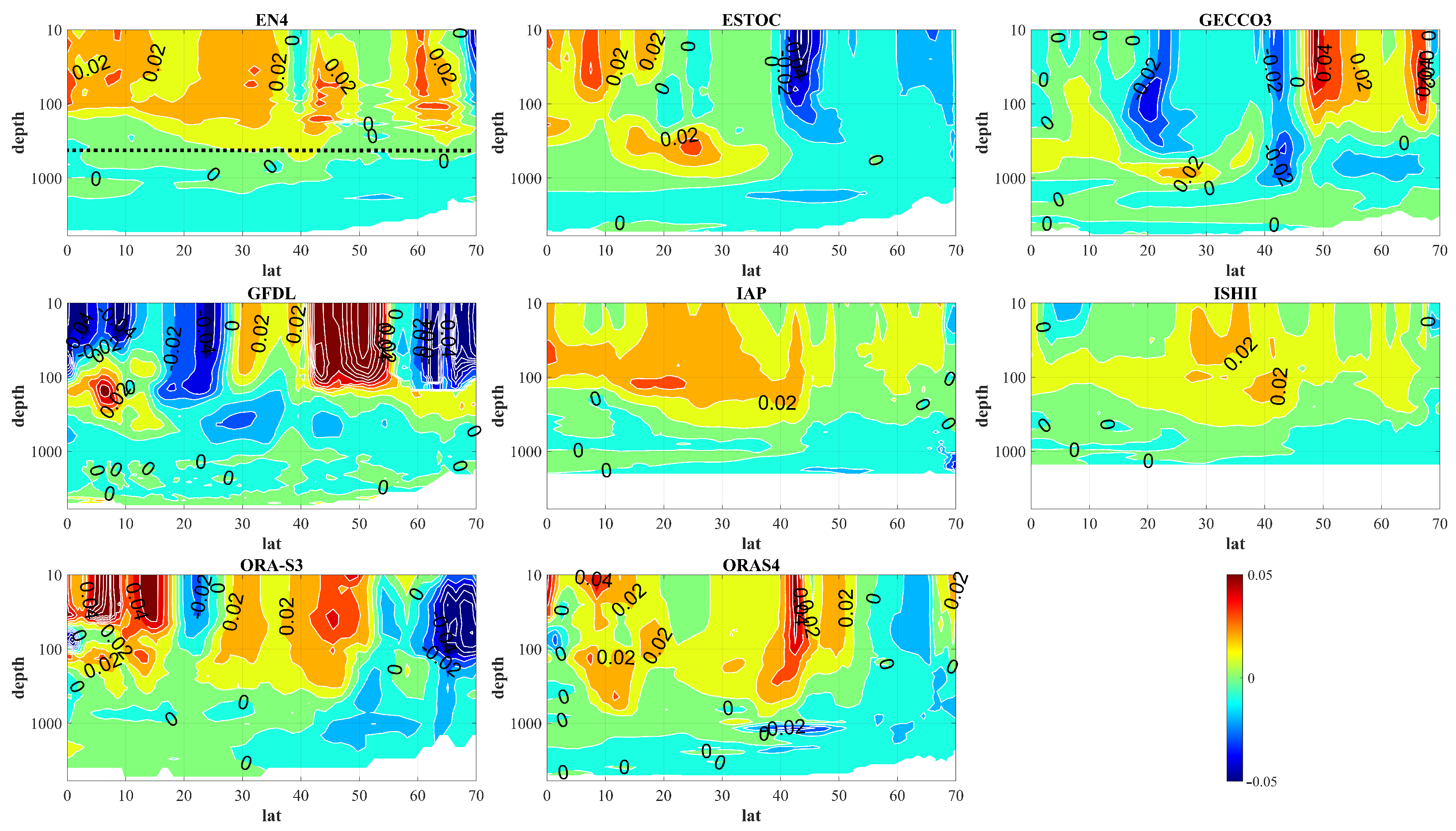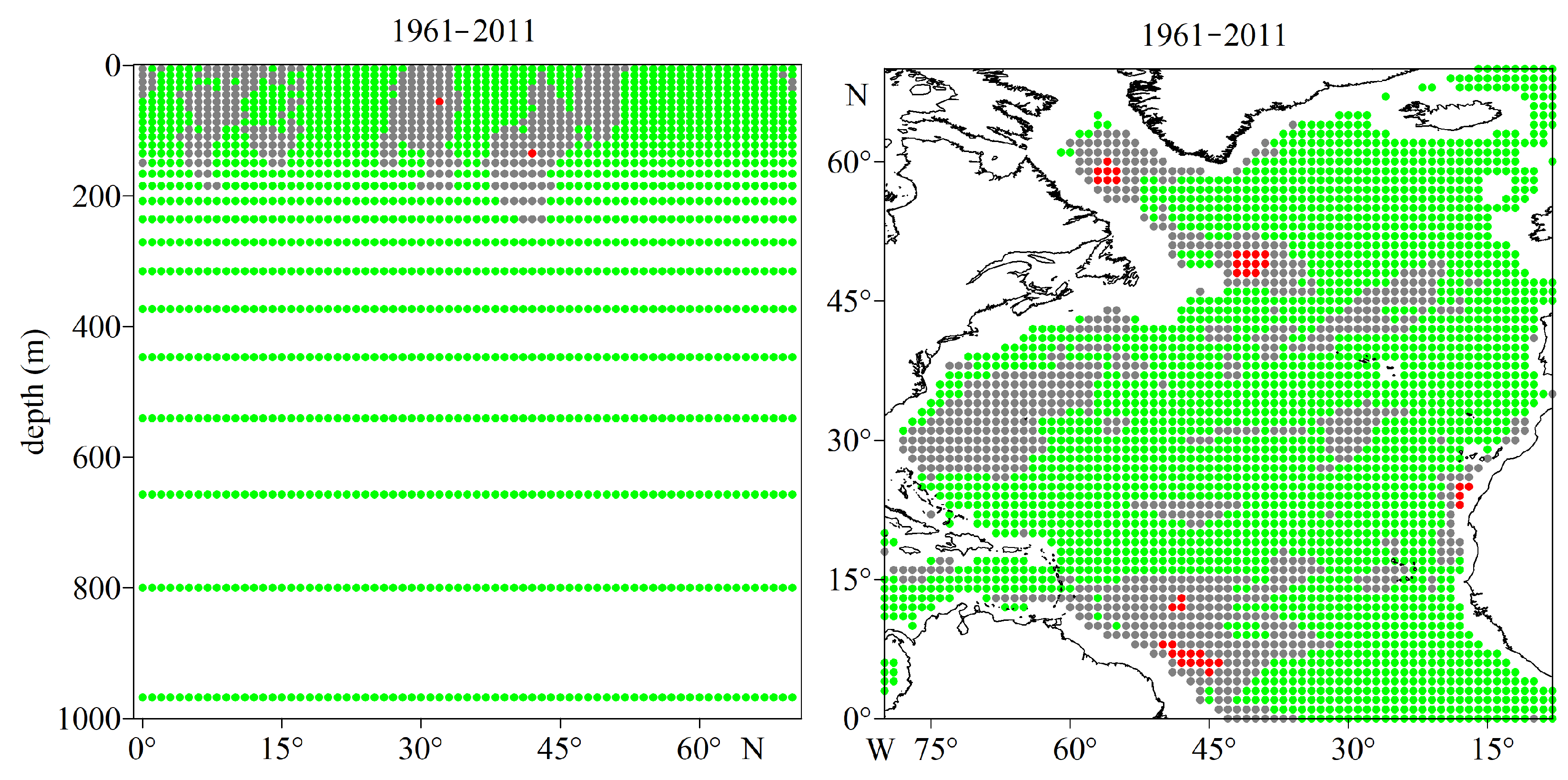Investigation of North Atlantic Salinity Long-Term Trends Based on Historical Datasets
Abstract
1. Introduction
2. Data and Methods
3. Results
3.1. 1948–2018
3.2. 1961–2011
3.3. Generalized Analysis for 1961–2011
4. Discussion
5. Conclusions
Author Contributions
Funding
Institutional Review Board Statement
Informed Consent Statement
Data Availability Statement
Acknowledgments
Conflicts of Interest
Abbreviations
| 3D-VAR/4D-VAR | Three- and Four-Dimensional VARiational assimilation |
| AO | Arctic Ocean |
| EN4 | Version 4 of datasets EN (originated from projets ENACT and ENSEMBLES) |
| ESTOC | Estimated State of the global Ocean for Climate research |
| GECCO3 | German contribution of the Estimating the Circulation and Climate of the |
| Ocean, version 3 | |
| GFDL | Geophysical Fluid Dynamics Laboratory |
| HOPE | Hamburg Ocean Primitive Equation model |
| IAP | Institute of Atmospheric Physics |
| MITgcm | Massachusetts Institute of Technology General Circulation Model |
| MOM3 | Modular Ocean Model version 3 |
| NA | North Atlantic |
| NEMO | Nucleus for European Modelling of the Ocean |
| NAO | North Atlantic Oscillation |
| ORA-S3 | Ocean Reanalysis System 3 |
| ORAS4 | Ocean Reanalysis System 4 |
| PSU | Practical Salinity Unit |
| SODA | Simple Ocean Data Assimilation |
| SPG | SubPolar Gyre |
| STG | SubTropical Gyre |
| SSS | Sea Surface Salinity |
| WO | World Ocean |
References
- Huang, R.; Luyten, J.; Stommel, H. Multiple equilibrium states in combined thermal and saline circulation. J. Phys. Oceanogr. 1992, 22, 231–246. [Google Scholar] [CrossRef][Green Version]
- Rahmstorf, S. Bifurcations of the Atlantic thermohaline circulation in response to changes in the hydrological cycle. Nature 1995, 378, 145–149. [Google Scholar] [CrossRef]
- Fedorov, A.; Pacanowski, R.; Philander, S.; Boccaletti, G. The effect of salinity on the wind-driven circulation and the thermal structure of the upper ocean. J. Phys. Oceanogr. 2004, 34, 1949–1966. [Google Scholar] [CrossRef]
- Mauritzen, C.; Melsom, A.; Sutton, R. Importance of density-compensated temperature change for deep North Atlantic Ocean heat uptake. Nat. Geosci. 2012, 5, 905–910. [Google Scholar] [CrossRef]
- Durack, P.; Wijffels, S.; Gleckler, P. Long-term sea-level change revisited: The role of salinity. Environ. Res. Lett. 2014, 9, 114017. [Google Scholar] [CrossRef]
- Yamaguchi, R.; Suga, T. Trend and variability in global upper-ocean stratification since the 1960s. J. Geophys. Res. Oceans 2019, 124, 8933–8948. [Google Scholar] [CrossRef]
- Li, G.; Cheng, L.; Zhu, J.; Trenberth, K.; Mann, M.; Abraham, J. Increasing ocean stratification over the past half-century. Nat. Clim. Chang. 2020, 10, 1116–1123. [Google Scholar] [CrossRef]
- Greene, C.; Monger, B.; McGarry, L.; Connelly, M.; Schnepf, N.; Pershing, A.; Belkin, I.; Fratantoni, P.; Mountain, D.; Pickart, R.; et al. Recent Arctic climate change and its remote forcing of Northwest Atlantic shelf ecosystems. Oceanography 2012, 25, 208–213. [Google Scholar] [CrossRef]
- Li, Y.; Fratantoni, P.; Chen, C.; Hare, J.; Sun, Y.; Beardsley, R.; Ji, R. Spatio-temporal patterns of stratification on the Northwest Atlantic shelf. Progr. Oceanogr. 2015, 134, 123–137. [Google Scholar] [CrossRef]
- Dessier, A.; Donguy, J. The sea surface salinity in the tropical Atlantic between 10° S and 30° N—seasonal and interannual variations (1977–1989). Deep Sea Res. Part I Oceanogr. Res. Pap. 1994, 41, 81–100. [Google Scholar] [CrossRef]
- Reverdin, G.; Kestenare, E.; Frankignoul, C.; Delcroix, T. Surface salinity in the Atlantic Ocean (30° S–50° N). Progr. Oceanogr. 2007, 73, 311–340. [Google Scholar] [CrossRef]
- Foltz, G.; McPhaden, M. Seasonal mixed layer salinity balance of the tropical North Atlantic Ocean. J. Geophys. Res. Ocean. 2008, 113, C02013. [Google Scholar] [CrossRef]
- Bingham, F.; Foltz, G.; McPhaden, M. Characteristics of the seasonal cycle of surface layer salinity in the global ocean. Ocean Sci. 2012, 8, 915–929. [Google Scholar] [CrossRef]
- Liu, Y.; Cheng, L.; Pan, Y.; Abraham, J.; Zhang, B.; Zhu, J.; Song, J. Climatological seasonal variation of the upper ocean salinity. Int. J. Climatol. 2022, 42, 3477–3498. [Google Scholar] [CrossRef]
- Boyer, T.; Levitus, S.; Antonov, J.; Locarnini, R.; Garcia, H. Linear trends in salinity for the World Ocean, 1955–1998. Geophys. Res. Lett. 2005, 32, L01604. [Google Scholar] [CrossRef]
- Durack, P.; Wijffels, S.; Matear, R. Ocean salinities reveal strong global water cycle intensification during 1950 to 2000. Science 2012, 336, 455–458. [Google Scholar] [CrossRef]
- Durack, P. Ocean salinity and the global water cycle. Oceanography 2015, 28, 20–31. [Google Scholar] [CrossRef]
- Sathyanarayanan, A.; Köhl, A.; Stammer, D. Ocean salinity changes in the global ocean under global warming conditions. Part I: Mechanisms in a strong warming scenario. J. Clim. 2021, 34, 8219–8236. [Google Scholar] [CrossRef]
- Hosoda, S.; Suga, T.; Shikama, N.; Mizuno, K. Global surface layer salinity change detected by Argo and its implication for hydrological cycle intensification. J. Oceanogr. 2009, 65, 579–586. [Google Scholar] [CrossRef]
- Melzer, B.; Subrahmanyam, B. Decadal changes in salinity in the oceanic subtropical gyres. J. Geophys. Res. Ocean. 2017, 122, 336–354. [Google Scholar] [CrossRef]
- Dickson, R.; Meincke, J.; Malmberg, S.A.; Lee, A. The “great salinity anomaly” in the Northern North Atlantic 1968–1982. Progr. Oceanogr. 1988, 20, 103–151. [Google Scholar] [CrossRef]
- Grodsky, S.; Carton, J.; Bingham, F. Low frequency variation of sea surface salinity in the tropical Atlantic. Geophys. Res. Lett. 2006, 33, L14604. [Google Scholar] [CrossRef]
- Antonov, J.; Levitus, S.; Boyer, T. Steric sea level variations during 1957–1994: Importance of salinity. J. Geophys. Res. Ocean. 2002, 107, 8013. [Google Scholar] [CrossRef]
- Curry, R.; Dickson, B.; Yashayaev, I. A change in the freshwater balance of the Atlantic Ocean over the past four decades. Nature 2003, 426, 826–829. [Google Scholar] [CrossRef]
- Reverdin, G.; Durand, F.; Mortensen, J.; Schott, F.; Valdimarsson, H.; Zenk, W. Recent changes in the surface salinity of the North Atlantic subpolar gyre. J. Geophys. Res. Ocean. 2002, 107, 8010. [Google Scholar] [CrossRef]
- Polyakov, I.; Bhatt, U.; Walsh, J.; Abrahamsen, E.; Pnyushkov, A.; Wassmann, P. Recent oceanic changes in the Arctic in the context of long-term observations. Ecol. Appl. 2013, 23, 1745–1764. [Google Scholar] [CrossRef]
- Rabe, B.; Karcher, M.; Kauker, F.; Schauer, U.; Toole, J.; Krishfield, R.; Pisarev, S.; Kikuchi, T.; Su, J. Arctic Ocean basin liquid freshwater storage trend 1992–2012. Geophys. Res. Lett. 2014, 41, 961–968. [Google Scholar] [CrossRef]
- Helm, K.; Bindoff, N.; Church, J. Changes in the global hydrological-cycle inferred from ocean salinity. Geophys. Res. Lett. 2010, 37, L18701. [Google Scholar] [CrossRef]
- Tesdal, J.E.; Abernathey, R.; Goes, J.; Gordon, A.; Haine, T. Salinity trends within the upper layers of the subpolar North Atlantic. J. Clim. 2018, 31, 2675–2698. [Google Scholar] [CrossRef]
- Liu, C.; Liang, X.; Chambers, D.; Ponte, R. Global patterns of spatial and temporal variability in salinity from multiple gridded Argo products. J. Clim. 2020, 33, 8751–8766. [Google Scholar] [CrossRef]
- Proshutinsky, A.; Krishfield, R.; Timmermans, M.L.; Toole, J.; Carmack, E.; McLaughlin, F.; Williams, W.; Zimmermann, S.; Itoh, M.; Shimada, K. Beaufort Gyre freshwater reservoir: State and variability from observations. J. Geophys. Res. Ocean. 2009, 114, C00A10. [Google Scholar] [CrossRef]
- Schroeder, K.; Chiggiato, J.; Bryden, H.; Borghini, M.; Ben Ismail, S. Abrupt climate shift in the Western Mediterranean Sea. Sci. Rep. 2016, 6, 23009. [Google Scholar] [CrossRef]
- Stammer, D.; Martins, M.; Köhler, J.; Köhl, A. How well do we know ocean salinity and its changes? Progr. Oceanogr. 2021, 190, 102478. [Google Scholar] [CrossRef]
- Durack, P.; Wijffels, S. Fifty-year trends in global ocean salinities and their relationship to broad-scale warming. J. Clim. 2010, 23, 4342–4362. [Google Scholar] [CrossRef]
- Wang, C.; Dong, S.; Munoz, E. Seawater density variations in the North Atlantic and the Atlantic meridional overturning circulation. Clim. Dyn. 2010, 34, 953–968. [Google Scholar] [CrossRef]
- Aretxabaleta, A.; Smith, K.; Kalra, T. Regime changes in global sea surface salinity trend. J. Mar. Sci. Eng. 2017, 5, 57. [Google Scholar] [CrossRef]
- Li, G.; Cheng, L.; Pan, Y.; Wang, G.; Liu, H.; Zhu, J.; Zhang, B.; Ren, H.; Wang, X. A global gridded ocean salinity dataset with 0.5° horizontal resolution since 1960 for the upper 2000 m. Front. Mar. Sci. 2023, 10, 1108919. [Google Scholar] [CrossRef]
- Cheng, L.; Trenberth, K.; Gruber, N.; Abraham, J.; Fasullo, J.; Li, G.; Mann, M.; Zhao, X.; Zhu, J. Improved estimates of changes in upper ocean salinity and the hydrological cycle. J. Clim. 2020, 33, 10357–10381. [Google Scholar] [CrossRef]
- Friedman, A.; Reverdin, G.; Khodri, M.; Gastineau, G. A new record of Atlantic sea surface salinity from 1896 to 2013 reveals the signatures of climate variability and long-term trends. Geophys. Res. Lett. 2017, 44, 1866–1876. [Google Scholar] [CrossRef]
- Reverdin, G.; Friedman, A.; Chafik, L.; Holliday, N.; Szekely, T.; Valdimarsson, H.; Yashayaev, I. North Atlantic extratropical and subpolar gyre variability during the last 120 years: A gridded dataset of surface temperature, salinity, and density. Part 1: Dataset validation and RMS variability. Ocean Dyn. 2019, 69, 385–403. [Google Scholar] [CrossRef]
- Vinogradova, N.; Lee, T.; Boutin, J.; Drushka, K.; Fournier, S.; Sabia, R.; Stammer, D.; Bayler, E.; Reul, N.; Gordon, A.; et al. Satellite salinity observing system: Recent discoveries and the way forward. Front. Mar. Sci. 2019, 6, 243. [Google Scholar] [CrossRef]
- Dinnat, E.; Le Vine, D.; Boutin, J.; Meissner, T.; Lagerloef, G. Remote sensing of sea surface salinity: Comparison of satellite and in situ observations and impact of retrieval parameters. Remote Sens. 2019, 11, 750. [Google Scholar] [CrossRef]
- Hernandez, O.; Boutin, J.; Kolodziejczyk, N.; Reverdin, G.; Martin, N.; Gaillard, F.; Reul, N.; Vergely, J. SMOS salinity in the subtropical North Atlantic salinity maximum: 1. Comparison with Aquarius and in situ salinity. J. Geophys. Res. Ocean. 2014, 119, 8878–8896. [Google Scholar] [CrossRef]
- Yu, L. Variability and uncertainty of satellite sea surface salinity in the subpolar North Atlantic (2010–2019). Remote Sens. 2020, 12, 2092. [Google Scholar] [CrossRef]
- Hu, R.; Zhao, J. Sea surface salinity variability in the western subpolar North Atlantic based on satellite observations. Remote Sens. Environ. 2022, 281, 113257. [Google Scholar] [CrossRef]
- Yang, S.C.; Rienecker, M.; Keppenne, C. The Impact of ocean data assimilation on seasonal-to-interannual forecasts: A case study of the 2006 El Niño Event. J. Clim. 2010, 23, 4080–4095. [Google Scholar] [CrossRef][Green Version]
- Hackert, E.; Ballabrera-Poy, J.; Busalacchi, A.; Zhang, R.H.; Murtugudde, R. Impact of sea surface salinity assimilation on coupled forecasts in the tropical Pacific. J. Geophys. Res. Ocean. 2011, 116, C05009. [Google Scholar] [CrossRef][Green Version]
- Shi, L.; Alves, O.; Wedd, R.; Balmaseda, M.A.; Chang, Y.; Chepurin, G.; Ferry, N.; Fujii, Y.; Gaillard, F.; Good, S.; et al. An assessment of upper ocean salinity content from the Ocean Reanalyses Intercomparison Project (ORA-IP). Clim. Dyn. 2017, 49, 1009–1029. [Google Scholar] [CrossRef]
- Good, S.; Martin, M.; Rayner, N. EN4: Quality controlled ocean temperature and salinity profiles and monthly objective analyses with uncertainty estimates. J. Geophys. Res. Ocean. 2013, 118, 6704–6716. [Google Scholar] [CrossRef]
- Gouretski, V.; Reseghetti, F. On depth and temperature biases in bathythermograph data: Development of a new correction scheme based on analysis of a global ocean database. Deep Sea Res. Part I Oceanogr. Res. Pap. 2010, 57, 812–833. [Google Scholar] [CrossRef]
- Cheng, L.; Zhu, J. Benefits of CMIP5 multimodel ensemble in reconstructing historical ocean subsurface temperature variations. J. Clim. 2016, 29, 5393–5416. [Google Scholar] [CrossRef]
- Ishii, M.; Kimoto, M.; Kachi, M. Historical ocean subsurface temperature analysis with error estimates. Mon. Weather Rev. 2003, 131, 51–73. [Google Scholar] [CrossRef]
- Osafune, S.; Masuda, S.; Sugiura, N.; Doi, T. Evaluation of the applicability of the Estimated State of the Global Ocean for Climate Research (ESTOC) data set. Geophys. Res. Lett. 2015, 42, 4903–4911. [Google Scholar] [CrossRef]
- Köhl, A. Evaluating the GECCO3 1948–2018 ocean synthesis—a configuration for initializing the MPI-ESM climate model. Q. J. R. Meteorol. Soc. 2020, 146, 2250–2273. [Google Scholar] [CrossRef]
- Chang, Y.S.; Zhang, S.; Rosati, A.; Delworth, T.; Stern, W. An assessment of oceanic variability for 1960–2010 from the GFDL ensemble coupled data assimilation. Clim. Dyn. 2013, 40, 775–803. [Google Scholar] [CrossRef]
- Balmaseda, M.; Vidard, A.; Anderson, D. The ECMWF ocean analysis system: ORA-S3. Mon. Weather Rev. 2008, 136, 3018–3034. [Google Scholar] [CrossRef]
- Balmaseda, M.; Mogensen, K.; Weaver, A. Evaluation of the ECMWF ocean reanalysis system ORAS4. Q. J. R. Meteorol. Soc. 2013, 139, 1132–1161. [Google Scholar] [CrossRef]
- Koenker, R.; Bassett, G. Regression Quantiles. Econometrica 1978, 46, 33–50. [Google Scholar] [CrossRef]
- Koenker, R. Quantile Regression; Econometric Society Monographs: Cambridge, UK, 2005; 349p. [Google Scholar]
- Timofeev, A.; Sterin, A. Using the quantile regression method to analyze changes in climate characteristics. Russ. Meteorol. Hydrol. 2010, 35, 310–319. [Google Scholar] [CrossRef]
- Kiktev, D.; Kryzhov, V. Comparison of several methods of assessment of statistical significance of linear trends. Russ. Meteorol. Hydrol. 2004, 11, 17–25. [Google Scholar]
- Deser, C.; Phillips, A.; Bourdette, V.; Teng, H. Uncertainty in climate change projections: The role of internal variability. Clim. Dyn. 2012, 38, 527–546. [Google Scholar] [CrossRef]
- Tebaldi, C.; Arblaster, J.; Knutti, R. Mapping model agreement on future climate projections. Geophys. Res. Lett. 2011, 38, L23701. [Google Scholar] [CrossRef]
- Marshall, J.; Kushnir, Y.; Battisti, D.; Chang, P.; Czaja, A.; Dickson, R.; Hurrell, J.; McCartney, M.; Saravanan, R.; Visbeck, M. North Atlantic climate variability: Phenomena, impacts and mechanisms. Int. J. Climatol. 2001, 21, 1863–1898. [Google Scholar] [CrossRef]
- Rosenheim, B.; Swart, P.; Thorrold, S.; Eisenhauer, A.; Willenz, P. Salinity change in the subtropical Atlantic: Secular increase and teleconnections to the North Atlantic Oscillation. Geophys. Res. Lett. 2005, 32, L02603. [Google Scholar] [CrossRef]
- Sarafanov, A. On the effect of the North Atlantic Oscillation on temperature and salinity of the subpolar North Atlantic intermediate and deep waters. ICES J. Mar. Sci. 2009, 66, 1448–1454. [Google Scholar] [CrossRef]




Disclaimer/Publisher’s Note: The statements, opinions and data contained in all publications are solely those of the individual author(s) and contributor(s) and not of MDPI and/or the editor(s). MDPI and/or the editor(s) disclaim responsibility for any injury to people or property resulting from any ideas, methods, instructions or products referred to in the content. |
© 2024 by the authors. Licensee MDPI, Basel, Switzerland. This article is an open access article distributed under the terms and conditions of the Creative Commons Attribution (CC BY) license (https://creativecommons.org/licenses/by/4.0/).
Share and Cite
Sukhonos, P.; Gusev, A.; Diansky, N. Investigation of North Atlantic Salinity Long-Term Trends Based on Historical Datasets. J. Mar. Sci. Eng. 2024, 12, 1404. https://doi.org/10.3390/jmse12081404
Sukhonos P, Gusev A, Diansky N. Investigation of North Atlantic Salinity Long-Term Trends Based on Historical Datasets. Journal of Marine Science and Engineering. 2024; 12(8):1404. https://doi.org/10.3390/jmse12081404
Chicago/Turabian StyleSukhonos, Pavel, Anatoly Gusev, and Nikolay Diansky. 2024. "Investigation of North Atlantic Salinity Long-Term Trends Based on Historical Datasets" Journal of Marine Science and Engineering 12, no. 8: 1404. https://doi.org/10.3390/jmse12081404
APA StyleSukhonos, P., Gusev, A., & Diansky, N. (2024). Investigation of North Atlantic Salinity Long-Term Trends Based on Historical Datasets. Journal of Marine Science and Engineering, 12(8), 1404. https://doi.org/10.3390/jmse12081404







